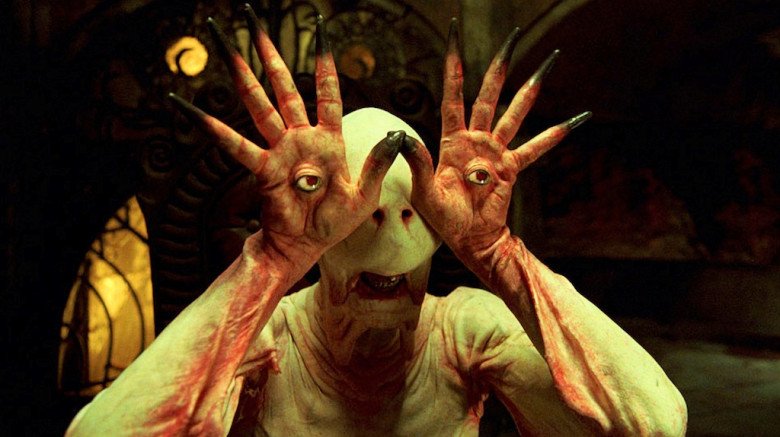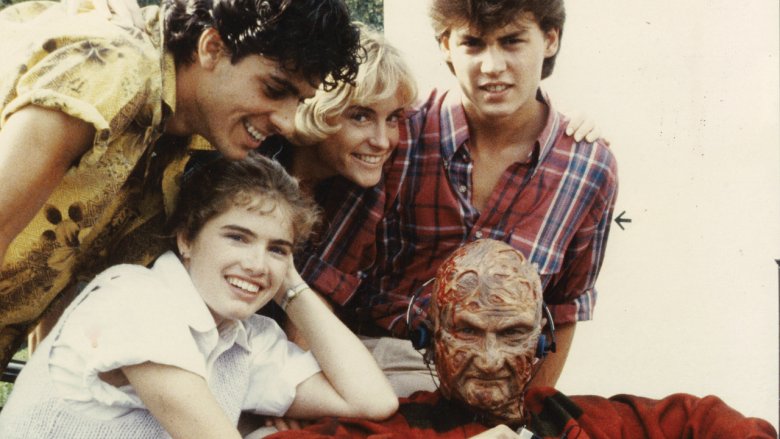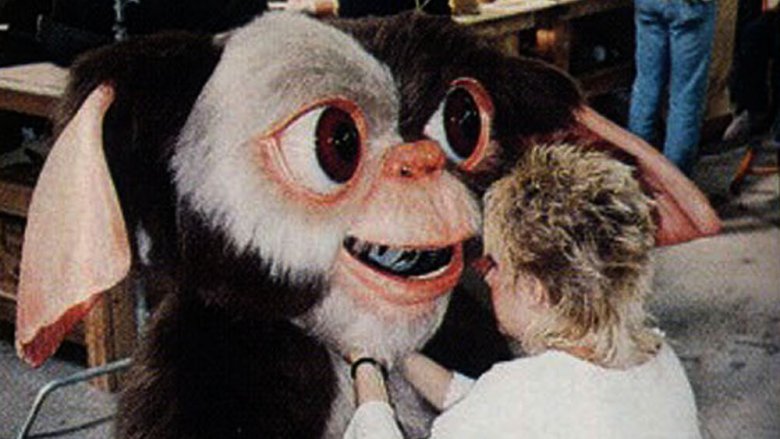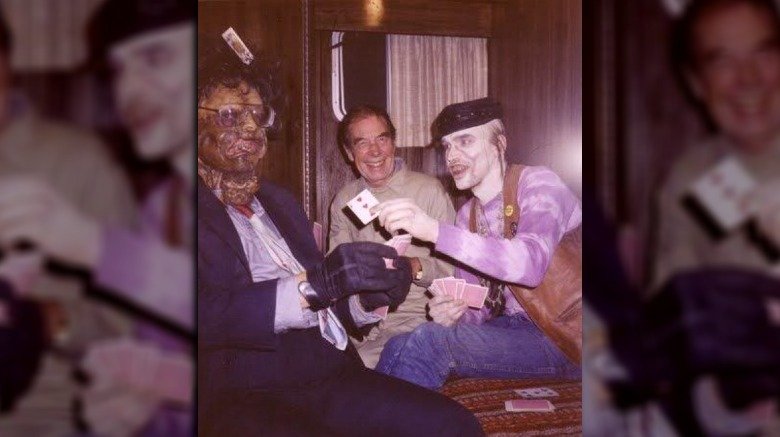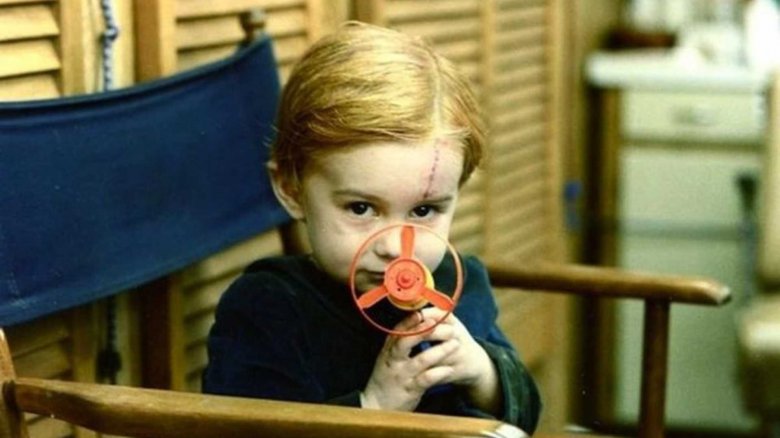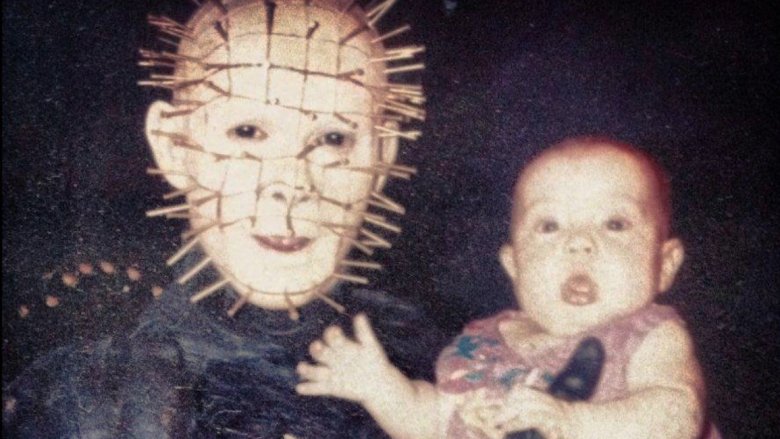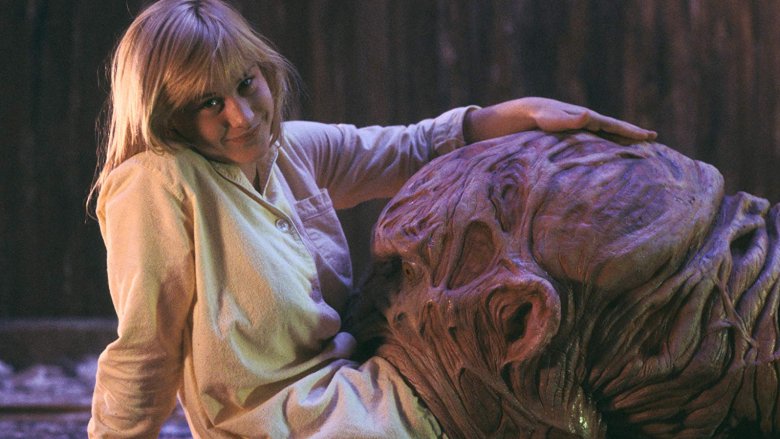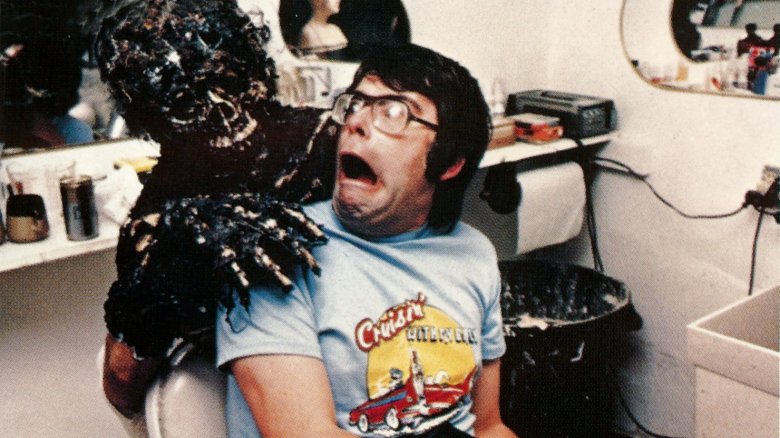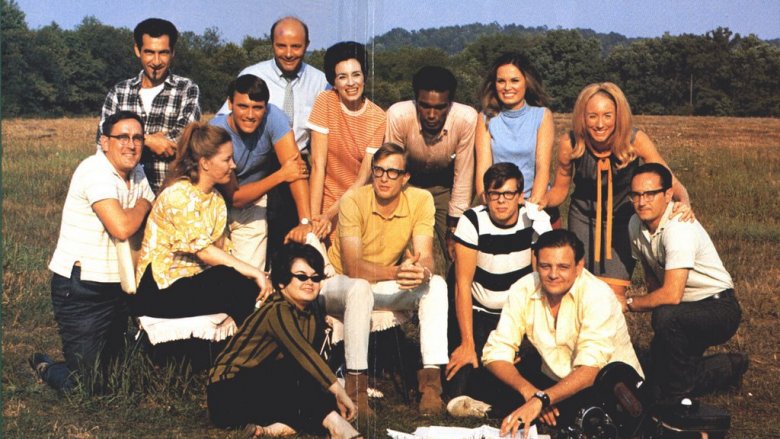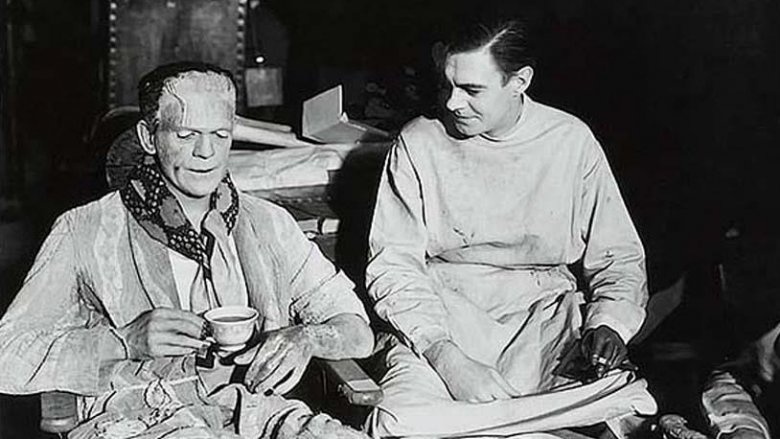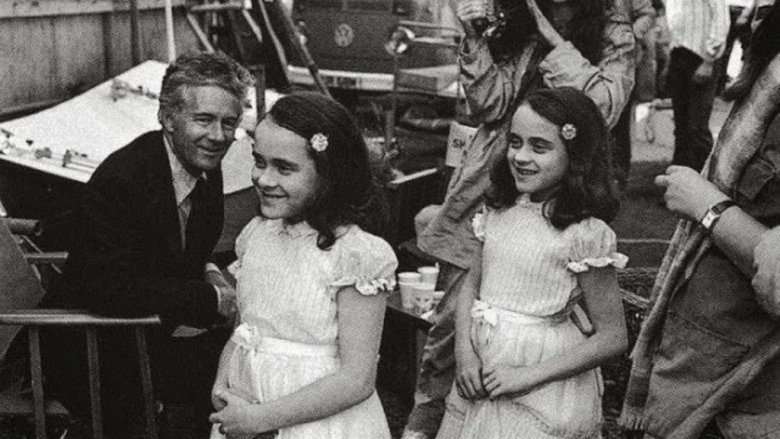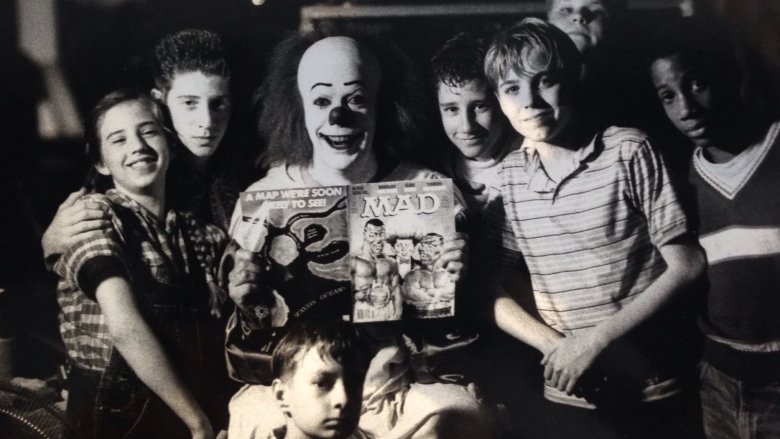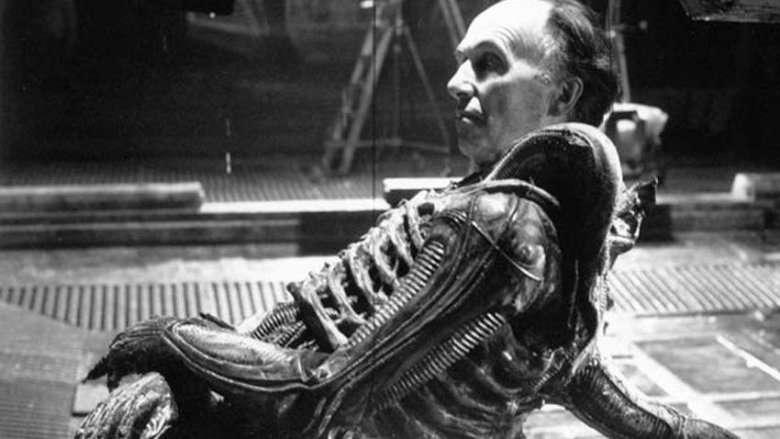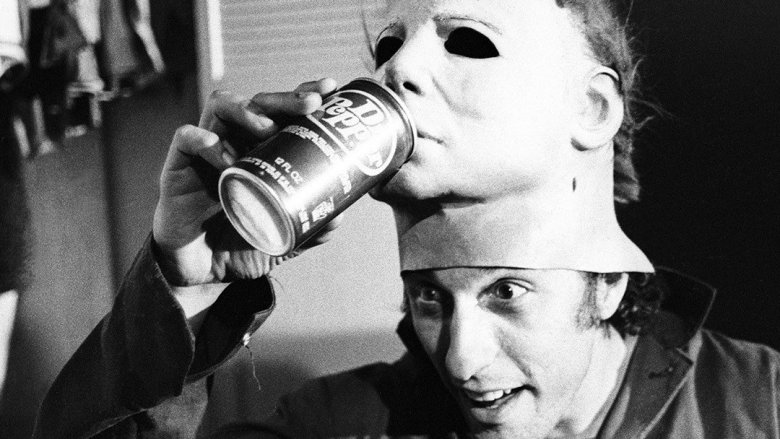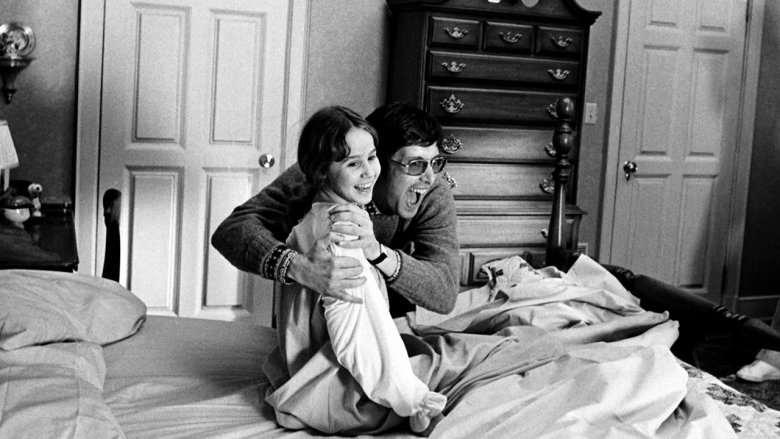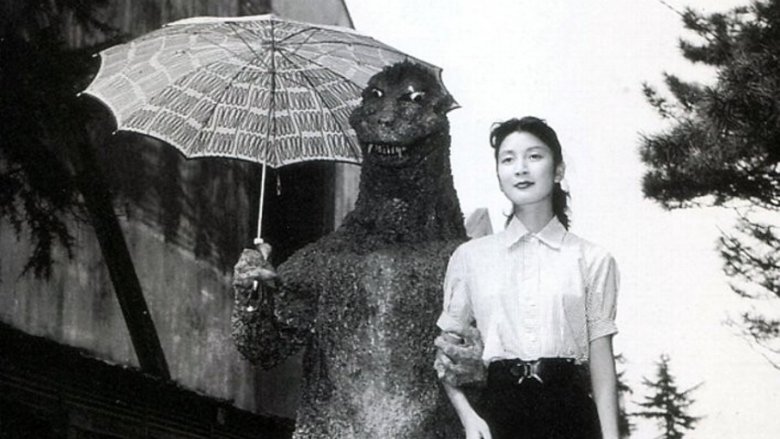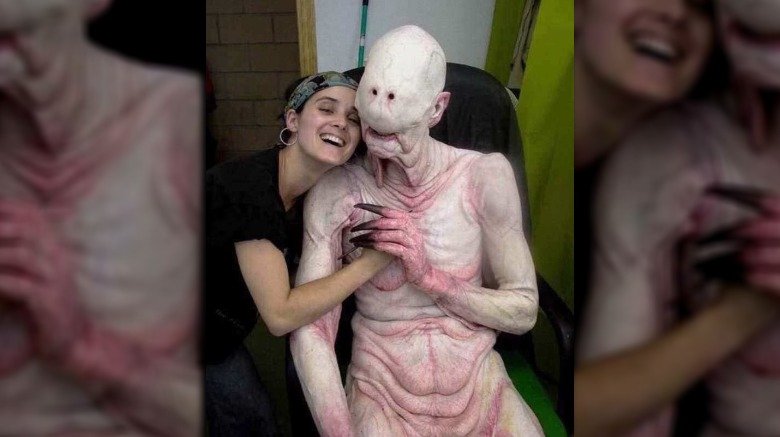Set Photos That'll Change The Way You See Horror Movies
Horror movies have been freaking out audiences at least since 1896's Le manoir du diable, using lighting, mood, and special effects to try to incite terror, suspense, and dread among their viewers. Additionally, master makeup artists and costume designers work together to create iconic nightmare fodder like Dracula, Frankenstein's monster, Freddy Krueger, or even the leprechaun from Leprechaun if that's what freaks your bean.
It turns out, however, that once you take away the spooky lighting, ominous music, and scary masks and makeup, a terrifying spectacle can easily become nothing more than just a bunch of people at work, having fun (sometimes) hanging out with the rest of the cast and crew, who are all in on the joke of their soundstage spookshow made by actors in tights covered in colored corn syrup. Few things can shatter the illusion of a spooky flick like behind-the-scenes photos of actors out of character, out of context, and out of costume. Here are some amusingly disillusioning set photos that will keep you from looking at iconic horror movies the same way ever again.
Freddy with a Walkman
The 1980s were definitely the decade of the slasher with franchises like Halloween, Friday the 13th, and The Texas Chainsaw Massacre doing huge business on the back of their iconic killers. But while classic murder boys Michael Myers, Jason Voorhees, and Leatherface inspire fear with their hulking forms and bladed weapons, none of them are exactly chatterboxes, making it hard for them to burst forth into leading man territory. Fortunately for the themed murderer community, one such charismatic figure would jump into the limelight in 1984 in the form of A Nightmare on Elm Street's Fred "Freddy" Krueger.
As the franchise went on and expanded into TV shows and video games and a 900 number phone line (children, Google what this means), Freddy — always deftly played by Robert Englund — would become quippier and punnier until he basically turned into the 1980s version of a Deadpool without a mask and who did slightly less murdering. But before he became such a cuddly figure that his commercial warned children to ask their parents for permission before talking to him on the phone, that dude was, you know, a serial killer with wizard powers who was probably also a child molester.
That's why it's kind of jarring to see him chilling with the teens he would dream-murder while bumping 1984's slappingest bops on a Walkman (children, Google what this means). And of course, the real irony is we know now that the actual monster, Johnny Depp, is standing behind him.
This extremely terrifying shot of Gizmo
The thing about most of these photos is that by tearing away the curtain of fantasy, they remind you that these monsters are just puppets or people in makeup who are going to eat a yogurt from craft services when the cameras stop rolling, breaking the illusion and removing most of the horror. The problem with this shot from behind the scenes of 1990's Gremlins 2: The New Batch is that it's actually way scarier than anything in the movie. (Especially if you consider that Gremlins 2 was more of a biting Hollywood satire mixed with goofball fourth wall-breaking farce than any legitimate attempt at horror.)
The adorable, non-evil mogwai Gizmo is arguably the hero and definitely the breakout star of the Gremlins franchise, so he's generally meant to be cute rather than scary. But according to Prop Store, makeup artist Rick Baker's team built a prototype human-sized suit for a small actor to fit into so Gizmo could walk around on camera. Thankfully, this idea was ditched and this horrifying, presumably child-eating suit that looks like the granddaddy of some Five Nights at Freddy's nightmare never appeared on camera. At this point, the more disturbing thing is that someone actually bought this suit and it's sitting in their house hopefully (please) in a storage case and not like on their body.
Leatherface cheats at cards
Look, everyone knows Leatherface is not a nice person. You see him bludgeon heads with a sledgehammer, impale people through the chest with a meat hook, butcher human flesh for consumption by himself and his family, wear a mask made of human skin, and — of course — massacre people with a chainsaw. There is no shortage of crimes performed by the saw-wielding manchild of the Sawyer clan, but cheating at cards seems a bridge too far.
The Texas Chain Saw Massacre from 1974 is one of the most influential and beloved horror films ever made. Its sequel, 1986's Texas Chainsaw Massacre 2, has something less of a critical consensus behind it, but its reputation has grown in recent years. Director Tobe Hooper wanted the second film to expand on the black comedy elements of the first film, so the sequel really amps up the satire as well as the gore to make something almost as over the top as the first film is understated. (Despite its title, only two people get killed with a chainsaw in the first film, and one of them is off-screen.)
That spirit of fun really shows in these behind-the-scenes photos, and especially in the above shot where you can see Leatherface (played in the sequel by Bill Johnson) playing cards with his brothers the Cook (Jim Siedow) and Chop Top (Bill Moseley) in a game that seems to have gone somewhat awry. Presumably that was a crazy game of poker.
Gage Creed goofing around
Creepy children are a genre staple for horror movies. Sometimes they're the source of the horror, like the Grady twins in The Shining, or Damien Thorn in The Omen, or Sadako in Ringu, or Toshio in Ju-On: The Grudge, or the Midwich Cuckoos in Village of the Damned or infinity other examples. Or sometimes the children's skin-crawling behavior is a sign that they are haunted or possessed and we feel afraid for them, like Regan MacNeil in The Exorcist or Danny Torrance in The Shining or Yoichi in Ringu.
One of the more memorable terrifying toddlers in film history is Gage Creed from the 1989 adaptation of Stephen King's Pet Sematary, as played by 3-year-old Miko Hughes. Hughes' performance as a dead child resurrected after being buried in accursed ground who slashes Herman Munster's Achilles tendon and bites his throat out before murdering his own mother with a scalpel is so effective that it's pretty easy to forget that he's actually a (presumably) normal and not-at-all accursed preschooler behind the scarface makeup.
So it's a little strange (and maybe more than a little relieving?) to see him in this behind-the-scenes shot just goofing around with toys. Is it a little worrying that the toy in question is a light firearm? Sure, yes. But it seems like even at that adorable child's most malicious, he's much less likely to shred throats with a flying disc gun than a scalpel.
Babyraiser
The Hellraiser franchise is made up of (currently) ten films that are about, uh ... *deep sigh* ... sex demons from another dimension in leather gear with elaborate body mods that steal people's souls via dark and edgy Rubik's Cubes so they can do experiments to them? And one of them *deepest, longest sigh* throws CDs like ninja stars? Look, not every horror franchise is for everyone.
Anyway, easily the most recognizable character from this Hot Topic mishmash of a franchise is Pinhead, the leader of the Cenobites (the facially pierced bondage demons), portrayed in the first eight (!) films by Doug Bradley. You can recognize Pinhead because he's the one with, you know, the pins in his head.
According to Birth Movies Death, while promoting Hellraiser III in 1992, Bradley was walking through New York in full makeup and costume so he could present a spooky Rubik's Cube to Planet Hollywood. Naturally, his presence drew quite a crowd, and at some point one of the dozens of people following him down the street asked him to take a picture holding their baby. Bradley refers to this as "Pinhead running for President." (Thankfully for Pinhead, sex evil has never been a disqualification from that particular office.)
The weird thing to think about is that that baby is now fully adult and probably wondering why their parent gladly handed them over to a demon that looks like he rolled around in Marilyn Manson's trash.
Another less than frightening Freddy
Wes Craven's A Nightmare on Elm Street ended up exploding into a massive franchise that comprised nine films including a remake and a crossover with Friday the 13th, a television series, novelizations, comic books, video games, and now two entries on this list. And out of all of that, the general consensus is that most of it is Not Very Good. The first film is a classic. The seventh installment, Wes Craven's New Nightmare, is well-regarded meta-horror that was an important step toward Craven's later film Scream, perhaps the most influential horror film of the 1990s. And fans of Renny Harlin's particular brand of madness will stump for part 4, The Dream Master. But pretty much everyone agrees that of all the sequels, the best one is the third, The Dream Warriors.
One of the most important additions to the Elm Street mythos in this film is the role of Kristen Parker — portrayed by Patricia Arquette — a young woman with the ability to summon other people into the dream world at will. And one of the most famous scenes in Dream Warriors is the one in which Freddy appears as a giant snake that tries to swallow Kristen whole until serpentine Freddy is stabbed with a shard of glass and pukes Kristen up.
As cool as that scene is, it's somewhat undercut by the above shot of Arquette not at all bothered to be halfway down Freddy's gullet.
Creeping on the King
The horror anthology film is a time-honored tradition that stretches at least as far back as 1919's Unheimliche Geschichten (aka Eerie Tales). High points include 1945's Dead of Night; the '60s and '70s contributions of Dr. Terror's House of Horrors, The House That Dripped Blood, and the staggering Kwaidan; and modern films like the V/H/S series and Southbound. But one of the best known and best loved horror anthologies continues to be the original Creepshow from 1982. Written by horror's most famous and prolific author, Stephen King (based partially on some of his short stories) and directed by George "Not Just Zombies" Romero, the movie is a loving homage to the horror comics of the 1950s, blending horror and dark humor into a satisfying package.
The film's cast includes many notable faces, such as Hal Holbrook, Adrienne Barbeau, and Ted Danson, but one notable role was played by King himself. King appears in the film's second segment, "The Lonesome Death of Jordy Verrill," based on his short story "Weeds."
Anyway, check out this fun backstage shot of King getting totally spooked on by a creepy ol' revenant from the ocean floor.
Night of the Living Color
George A. Romero's 1968 classic Night of the Living Dead is one of the most influential horror movies of all time, completely reinventing the popular conception of zombies from their origin as mind-controlled slaves of a voodoo master to the shambling hordes of the undead that still show up on The Walking Dead sometimes. Furthermore, the movie would go on to inspire literally dozens of sequels of various levels of legitimacy, from Romero's own Dawn of the Dead and follow-ups to the comedic Return of the Living Dead series to the Italian Zombi series to numerous remakes. It's so complicated you literally need a flowchart to follow it.
One of the key elements to the tone of the film is its stark black and white photography, which was partially due to budgetary issues but also because Romero thought black and white made the blood feel more real. That's why it was so shocking to see a collection of behind-the-scenes photos from NotLD in full color. The scenes of cast members chilling on picnic blankets or of Barbra and Johnny in the graveyard seem way cheerier and less ominous in full color. "They're coming to get you, Barbra ... to take you to the mall for an Orange Julius!"
Frankenstein breaks for tea
In the 1930s and 1940s, the undisputed leader in the field of horror cinema was Universal Studios, which kicked off the entire trend of American horror with 1931's Dracula and then only grew its brand with such franchises as Frankenstein, The Mummy, and The Invisible Man, all of which have more sequels than you would probably guess unless you're a classic horror buff. In many ways, the Frankenstein franchise was the tentpole for Universal — at least until 1941's The Wolf Man pushed Lon Chaney, Jr.'s Larry Talbot to the forefront — and the film generally (and rightly) regarded as the best one in the whole Universal Monsters stable is 1935's Bride of Frankenstein.
Key to the success of the film, and indeed of the franchise as a whole, are the iconic creature makeup effects by Jack Pierce, including that of the Frankenstein monster as portrayed by Boris Karloff and the titular bride, played by Elsa Lanchester. Although the second film in the series spends much of its runtime humanizing the monster, teaching him to appreciate friendship, music, and a good cigar, the shrieking disapproval of the monster's mate causes him to conclude that "we belong dead." As such, there's some humor in seeing this gallery of shots that show Karloff in his monster face enjoying a cup of tea or a smoke, or Lanchester skillfully applying her own makeup. Or, if you'd rather, check out this set photo from Son of Frankenstein with Karloff's monster enjoying not only tea, but a slice of toast as well.
Literally anyone smiling on the set of The Shining
Stanley Kubrick's 1980 adaptation of The Shining is another film that constantly rates on "best of horror" lists, thanks to Kubrick's meticulous direction, instantly memorable images and dialogue, and powerful performances from the cast, perhaps most notably Jack Nicholson, as well as that truly eye-popping poster in Scatman Crothers' room.
However, as this article and gallery from the Mind Circle relates, filming The Shining was no easy feat for most of its cast and crew. Kubrick's perfectionism meant constant last-minute script changes, long working days, and harsh treatment of his cast, most notably Shelly Duvall, who became so stressed from her frequent arguments with Kubrick that she became physically ill, with her hair reportedly starting to fall out from stress.
So between the grim subject matter of the film and the tense and wearying atmosphere on the set, it's hard to imagine anyone taking a moment to smile over what they were doing. And yet, smiles are visible all over the photos from the set, like this crew member with an ax in his chest, Kubrick and Nicholson reviewing some footage, and even Kubrick and Duvall smiling together, though her smile is probably fake. But perhaps the strangest of all is the above shot of Lisa and Louise Burns as the Grady sisters, smiling in a totally normal way that little girls do, and not at all implying that they would definitely murder you and then maybe also each other.
Pennywise and the Losers
2017 saw the release of the hugely successful theatrical adaptation of Stephen King's It, but '90s kids will remember the 1990 mini-series starring Tim Curry as Pennywise the Clown, as well as a host of actors we swear were famous in the '80s, like John Ritter, Harry Anderson, and Jonathan Brandis. Also Seth Green was in it, playing the same character Finn Wolfhard played in the 2017 version, just in case you want to break your brain imagining those two as the same person. For kids in the '90s, this televised event was all the buzz at school as they talked in hushed tones about the child-eating sewer clown and spraying imaginary battery acid in his face, even though someone watching it now would probably find it less scary than an episode of Little Clowns of Happytown.
The premise, of course, is that an ancient evil takes the form of a clown who is opposed by a group of '50s nerd kids called the Losers Club, who are the only ones in town who truly understand the depth of evil lurking under their town. Given how much time the clown and kids spend trying to eat and kill each other respectively, it's pretty unnerving to see Pennywise and the Losers chilling with sincere smiles and an issue of MAD Magazine, just like it's kind of weird and sad to see Tim Curry in full clown regalia taking a smoke break in the rain.
Headless xenomorph
Ridley Scott's 1979 masterpiece Alien is basically a heart-stopping haunted house flick, but the house is a spaceship and the ghost is a glistening black sex monster in a bondage suit whose head is a giant ding-a-ling with another, smaller ding-a-ling poking out its throat. As Alien went on to spawn a franchise, the erotically charged titular aliens — designed by H.R. Giger and known (somewhat erroneously) by fans as xenomorphs — have naturally become a centerpiece of the franchise, spraying acid blood and drooling K-Y Jelly all over Sigourney Weaver or Winona Ryder or whoever.
That's why it's a weird mix of unsettling and reassuring to see the actors playing the alien without their masks on, as in this gallery of behind-the-scenes snaps and production stills from the original movie. In Alien, the titular creature was played by Nigerian design student Bolaji Bodejo, whose 6' 10" frame was thought to bear arms and legs so long and slender that they seemed inhuman. In this picture, however, he just kind of looks like a guy who is really uncomfortable and actually kind of bored in the incredibly expensive Halloween costume his friends made him wear.
Alternatively, stuntman Eddie Powell, seen above wearing the suit without the headpiece, looks totally chill and not at all like an otherworldly beast that wants to lay eggs in your chest via your throat. To be fair, it's hard to know what's going on in his head at that moment, though.
Maskless Michael Myers
Although the subgenre has its roots in 1960s psychological thrillers like Psycho and Peeping Tom and Italian gialli like Twitch of the Death Nerve, the golden age of the slasher film was definitely the late '70s and early '80s. And while movies like Texas Chain Saw Massacre and Black Christmas preceded it by a few years, the movie that really kicked off the slasher craze was 1978's Halloween.
While nearly every element of Halloween's production has led to its enduring popularity, from John Carpenter's direction to his screenplay (co-written with Debra Hill) to his iconic score, the key to a successful slasher franchise is always going to revolve around the killer, and Halloween's Michael Myers set the standard that many later franchises would try to reach.
The most recognizable aspect of Michael Myers is his well-known mask, which was famously made by altering a Captain Kirk mask, and which Myers is almost never seen without in the course of the franchise. The Shape, as Myers is called in the film's credits, is played by Nick Castle, a friend of Carpenter's who would go on to direct such films as The Last Starfighter. Despite Myers' constant menacing presence in the film, this gallery of behind-the-scene shots from the Halloween franchise shows that apparently Castle had a lot of fun making goofs with his famous mask, including the above shot of ol' Mikey Myers enjoying the 23 famous flavors of a Dr Pepper.
Regan smiles
1973's The Exorcist is almost invariably placed near the top of any "best horror movies ever" list, and not without good reason. It was nominated for ten Academy Awards and was the first horror film ever nominated for best picture. Although it would lose best picture to The Sting, it would win best sound mixing and best adapted screenplay, a relatively rare achievement for a horror film.
At the heart of both William Peter Blatty's novel that served as the basis for the film and his own screenplay adaptation of the book is the anxiety surrounding a little girl in danger, as she becomes literally unrecognizable through demonic possession, or puberty, or both. Much of the horror comes from the juxtaposition of the innocent-looking Regan, famously played by Linda Blair, and the horrible things coming out of her mouth (whether terrible cusses or pea soup) as she spins her head around, levitates her bed, and pees at an astronaut.
Since so much of the film centers on Regan's possession and torment, the most memorable images from the movie tend to include her demonically grinning face and not much in the way of her smiling with genuine happiness. That's why it's strange to look at behind-the-scenes photos and footage and see young Linda Blair smiling with co-stars, makeup artists, and director William Friedkin. Sure, she's all smiles now, but you wouldn't believe what she says about their mothers behind their backs.
Hannibal Lecter getting his fry on
As murder movies go, it's pretty hard to beat 1991's The Silence of the Lambs in terms of critical acclaim. It was only the third film ever to take home the Academy Awards' five top prizes — best picture, best director, best actor, best actress, and best screenplay — and as of this writing, it's the only horror film ever to win best picture.
Of course the breakout character from the film is suave serial killer Hannibal "the Cannibal" Lecter. Lecter had previously appeared in the 1986 film Manhunter, played by Brian Cox, but it was Silence of the Lambs that turned him into a franchise player, leading to 2001's Hannibal, 2002's Red Dragon, 2006's Hannibal Rising, and the 2013-2015 gourmet cooking show also called Hannibal. (He made people into really luxurious people meals.)
But while Lambs famously had Lecter bragging about eating a human liver with fava beans and a nice chianti, this collection of set photos indicates that maybe liver and beans couldn't easily slide through Anthony Hopkins's now-iconic man-muzzle if he got hungry while filming. As such, it was apparently necessary for director Jonathan Demme to feed him French fries through the tiny mouth bars on his mask, an act that apparently cracked Demme up. (This would be a really good place for a lamb fries joke, but it only works if you know that lamb fries are lamb testicles. Anyway. Lamb fries are lamb testicles.)
Kissing Godzilla
Although the Godzilla franchise stars a monster — indeed, the King of the Monsters – and focuses on themes of postwar anxiety about man's hubris and the overreach of science in the wake of the atomic bomb, they're not really horror films per se. They're monster movies, but not quite in the sense that, say, Frankenstein is. They're more about spectacle and boss monster fights than atmosphere and creeping terror. Still, Godzilla is one of the most iconic monsters there is, and thanks to the long-running success of the character in both Japan and America, there is no shortage of cool, sweet, and downright weird behind-the-scenes photos.
For example, this really great gallery features Godzilla actor Haruo Nakajima half out of costume drinking tea, Godzilla delivering Christmas gifts, Godzilla seemingly passed out on a giant wheelbarrow, and Godzilla dancing in space or something? More importantly, it also features a series of photos that seem to indicate evidence of a Dateable Godzilla. Here's someone (probably Haruo Nakajima?) kissing the King square on the lips, here he is immediately after the classic "yawn and stretch" move, here he is busting out "Wonderwall" for a hula dancer, here's a little photo booth action from his date at the mall, and most importantly, the photo above where he's politely escorting another date home with a parasol.
Then again, this picture seems to show Baragon putting the moves on some bikini ladies, so maybe big G has some competition for King of All Players.
Cuddling with the Pale Man
2006's Pan's Labyrinth was arguably the film that made Guillermo del Toro a household name after cult horror films like Cronos and The Devil's Backbone and comic book adaptations like Blade II and Hellboy. The film introduced to American audiences del Toro's penchant for using movie monsters to address real-world social issues, a tendency that would ultimately win him best picture and best director Oscars for The Shape of Water. In the case of Pan's Labyrinth, del Toro uses dark fantasy to create a dream world in which the horrors of fascist Spain under Francisco Franco are reflected by the horrors of, like, a big maze with monsters in it.
The monster who gives his name to the title is the Faun (this makes more sense if you know that the film's title in the original Spanish is El Laberinto del Fauno, or if you know that the Greek god Pan was a faun, also known as a satyr), but the real nightmare star of the film is the Pale Man, whose "eyeballs in the palms" bit is probably the most memorable visual in the film. The actor behind the Faun would probably be mad that the Pale Man upstaged him if it weren't for the fact that they were played by the same actor: Doug Jones. Jones is reportedly a very nice person despite his monstrous roles, so maybe it's no surprise to see him showing some affection behind the scenes to makeup artist Montse Ribé.
